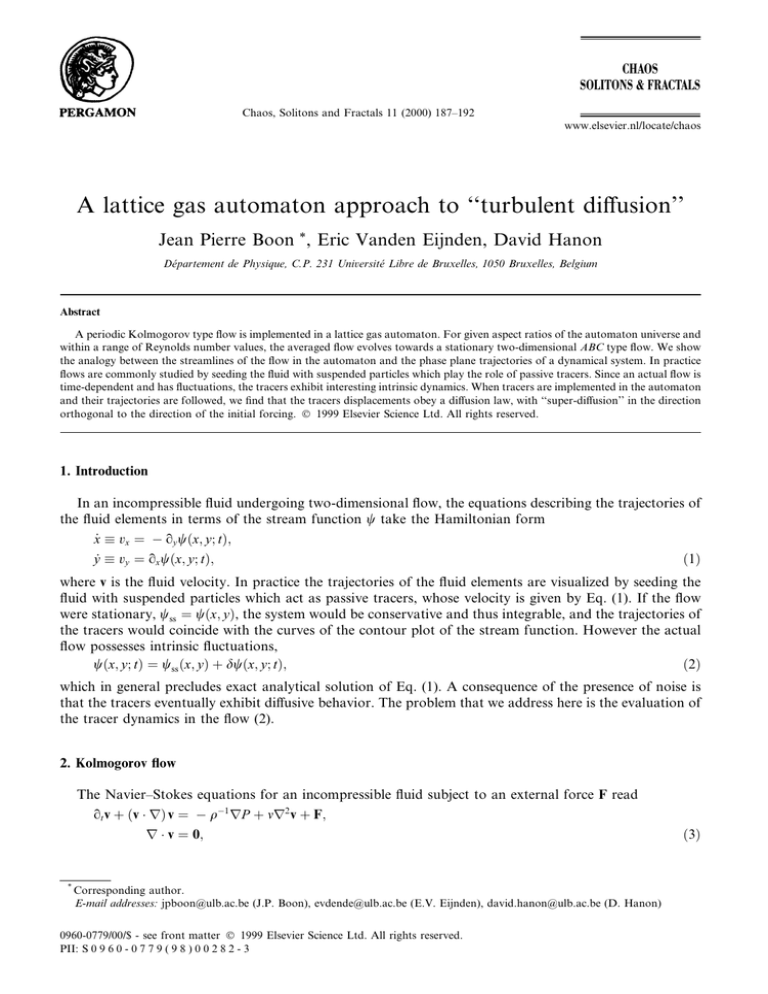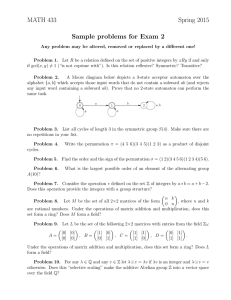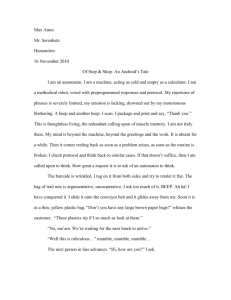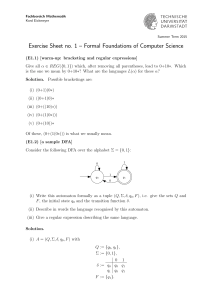
Chaos, Solitons and Fractals 11 (2000) 187±192
www.elsevier.nl/locate/chaos
A lattice gas automaton approach to ``turbulent diusion''
Jean Pierre Boon *, Eric Vanden Eijnden, David Hanon
D
epartement de Physique, C.P. 231 Universit
e Libre de Bruxelles, 1050 Bruxelles, Belgium
Abstract
A periodic Kolmogorov type ¯ow is implemented in a lattice gas automaton. For given aspect ratios of the automaton universe and
within a range of Reynolds number values, the averaged ¯ow evolves towards a stationary two-dimensional ABC type ¯ow. We show
the analogy between the streamlines of the ¯ow in the automaton and the phase plane trajectories of a dynamical system. In practice
¯ows are commonly studied by seeding the ¯uid with suspended particles which play the role of passive tracers. Since an actual ¯ow is
time-dependent and has ¯uctuations, the tracers exhibit interesting intrinsic dynamics. When tracers are implemented in the automaton
and their trajectories are followed, we ®nd that the tracers displacements obey a diusion law, with ``super-diusion'' in the direction
orthogonal to the direction of the initial forcing. Ó 1999 Elsevier Science Ltd. All rights reserved.
1. Introduction
In an incompressible ¯uid undergoing two-dimensional ¯ow, the equations describing the trajectories of
the ¯uid elements in terms of the stream function w take the Hamiltonian form
x_ vx ÿ oy w
x; y; t;
1
y_ vy ox w
x; y; t;
where v is the ¯uid velocity. In practice the trajectories of the ¯uid elements are visualized by seeding the
¯uid with suspended particles which act as passive tracers, whose velocity is given by Eq. (1). If the ¯ow
were stationary, wss w
x; y, the system would be conservative and thus integrable, and the trajectories of
the tracers would coincide with the curves of the contour plot of the stream function. However the actual
¯ow possesses intrinsic ¯uctuations,
2
w
x; y; t wss
x; y dw
x; y; t;
which in general precludes exact analytical solution of Eq. (1). A consequence of the presence of noise is
that the tracers eventually exhibit diusive behavior. The problem that we address here is the evaluation of
the tracer dynamics in the ¯ow (2).
2. Kolmogorov ¯ow
The Navier±Stokes equations for an incompressible ¯uid subject to an external force F read
ot v
v r v ÿ qÿ1 rP mr2 v F;
r v 0;
*
Corresponding author.
E-mail addresses: jpboon@ulb.ac.be (J.P. Boon), evdende@ulb.ac.be (E.V. Eijnden), david.hanon@ulb.ac.be (D. Hanon)
0960-0779/00/$ - see front matter Ó 1999 Elsevier Science Ltd. All rights reserved.
PII: S 0 9 6 0 - 0 7 7 9 ( 9 8 ) 0 0 2 8 2 - 3
3
188
J.P. Boon et al./Chaos, Solitons and Fractals 11 (2000) 187±192
where P is the hydrostatic pressure, q the mass density, and m the kinematic viscosity. When the ¯ow is twodimensional and F has the form
F U1x cos
jy;
j
2p=L;
4
where L is the extension of the system in the y-direction, Eq. (3) describe the periodic Kolmogorov ¯ow [1].
Alternately, with w de®ned by Eq. (1), the Navier±Stokes equations can be recast in the form
ot ÿ Reÿ1 r2 w J
w; Dw Reÿ1 cos
jy;
5
Here Re w0 =m is the Reynolds number, where w0 is de®ned by wss w0 cos
jy, and J
w; Dw is the
Jacobian
J
w; Dw ox woy Dw ÿ oy wox Dw:
6
By linear stability analysis, one can show that there exists a critical value of the Reynolds number where
the system becomes unstable. This is most easily seen by considering a perturbation to the velocity ®eld
vx vss
x dvx ;
vy vss
y dvy
7
with
vss
x
U
cos
jy;
mj2
vss
y 0
8
and evaluating the perturbation evolution in response to the imposed forcing. We write the perturbation in
terms of its spatial Fourier components as
dvx
x; y; t eõqx /
y; t;
dvy
x; y; t eõqx u
y; t
9
with
/
y; t
1
X
kÿ1
eõky /k
t;
u
y; t
1
X
kÿ1
eõky uk
t:
10
We insert (7) with (9) and (10) into the Navier±Stokes equations which are then Laplace±Fourier transformed to obtain the characteristic equation and the dispersion equation; retaining only the modes
k 0; k j, and k ÿj (i.e. setting to zero the amplitudes of the modes with jkj > j), we obtain from the
characteristic equation the value of the critical Reynolds number
p
j 2 q2
;
11
Rec 2 mj2
1=2
j2 ÿ q2
and from the dispersion equation the modes
dvx
q; t es t ;
sÿ t
dvy
q; t e ;
s ÿ mj2 mq2 ;
2
sÿ ÿ mq ;
12
13
2
with 1 ÿ
Re=Rec . Eq. (13) shows that the mode dvy orthogonal to the direction of the forcing (along
the x-axis) exhibits critical slowing down, i.e. sÿ ! 0 when Re ! Rec . At Re Rec , the Kolmogorov ¯ow
becomes unstable, and beyond the bifurcation (Re > Rec ) goes into a two-dimensional ABC type ¯ow [2]
with closed streamlines, separatrices, and in®nite trajectories between separatrices, as illustrated in Fig. 1.
3. Lattice gas automaton dynamics
The ¯ow to be investigated is produced by a lattice gas automaton 1 which we brie¯y describe. A lattice
gas automaton can be viewed as a collection of particles residing in a discrete space, a regular d-dimensional
1
For a review on lattice gas automata, see [3].
J.P. Boon et al./Chaos, Solitons and Fractals 11 (2000) 187±192
189
Fig. 1. Contour plot of the stream function w
x; y at Re=Rec 2:5. The streamlines shown here are obtained from the lattice gas
automaton described in Section 3 and subject to a periodic forcing according to Eq. (8). The horizontal plane is the L-plane (dimensions are given in lattice units) and the vertical axis gives the amplitude of the stream function w
x; y (in arbitrary units).
lattice L, where they move at discrete time steps. Associated to each lattice node (with position denoted by
r) there is a ®nite set of channels (labeled by Latin indices i; j; . . .). Each of these channels corresponds to a
discrete value of the velocity
ci that a particle positioned at the speci®ed node may have. An exclusion
principle imposes that there be a maximum of one particle per channel. The exclusion principle is important
because it allows a symbolic representation of the state of the system in terms of bits, and of its dynamics in
terms of operations over sets of bits, which are easily implemented on a computer. The state of the automaton at time t is thus described by specifying the con®guration on each and every node, i.e. the set of bits
b
fni
r; tgi1 , r 2 L, for an automaton with b channels per node. The evolution of the automaton takes place
in two stages : propagation and collision, applied sequentially at every time step. Particles are ®rst moved
according to their velocity: If channel i at node r is occupied, the propagation step displaces that particle to
channel i of node r ci Dt. This updating is done synchronously throughout the lattice. The second stage in
the dynamics is a local collision step: As a function of the pre-collisional con®guration, a new con®guration
is chosen by a prescription based on a set of (usually stochastic) rules. This step is crucial to determine the
type of physics the automaton will exhibit at the macro- and mesoscopic levels. In particular, the collision
step should preserve the quantities that are invariant under the dynamics of the model system. For example,
it is possible to construct thermal automata whose rules are such that the number of particles, the momentum and the energy remain unchanged by the collision step [4]. In general, there will be several sets of
collision rules consistent with the invariance of the speci®ed constants of motion under the collision step.
The choice of a particular set is then dictated by operational convenience, or by the need to explore a
particular physical regime. Here we are interested in the two-dimensional hydrodynamic regime and it
suces to implement a simple set of rules governing the automaton dynamics on a triangular lattice [5]. It
can be shown, starting from the microscopic equations of the automaton, that, provided the symmetry of
the lattice is sucient, the macroscopic dynamics of the automaton is consistent with the Navier±Stokes
equation [6]. It is one of the virtues of the lattice gas automaton that on the sole basis of microscopic rules
in accordance with local invariance and symmetry properties, its macroscopic behavior produces correct
hydrodynamics.
Furthermore the lattice gas automaton exhibits two important features: (i) it possesses a large number of
degrees of freedom; (ii) its Boolean microscopic nature combined with stochastic micro-dynamics results in
intrinsic spontaneous ¯uctuations, and it has been shown that these ¯uctuations capture the essentials of
actual ¯uctuations in real ¯uids [7]. Therefore the lattice gas automaton can be considered as a reservoir of
excitations extending over a wide range of frequencies and wavelengths.
4. Tracer dynamics
Tracers are implemented as suspended particles in the following way. The tracer, which we denote as a
t-particle, is subjected to the cooperative eects of the ¯uid particles, and its dynamics results from the local
190
J.P. Boon et al./Chaos, Solitons and Fractals 11 (2000) 187±192
dynamics of the automaton, that is from the combined eects of deterministic advection (due to the nonzero average velocity ®eld resulting from the constraint imposed to the lattice gas) and random advection
(due to the automaton intrinsic ¯uctuations). The t-particle undergoes displacements according to the
average velocity of the ¯uid particles computed over a local domain of L and over a number (b) of time
steps of the automaton (bDt). In the absence of external force (Re 0, that is w0 0 in the notation of
Section 2), the dynamics of the t-particle is governed solely by the automaton noise and the tracers undergo
random motion leading to diusive behavior over long distances and long times, i.e.
hdx2
ti hdy 2
ti 2D0 t, for t Dt, where D0 will be referred to as the coecient of molecular diusion,
and Dt is the elementary time step of the automaton. The value of b can be varied to modify the eect of
noise and thereby to tune the coecient of molecular diusion D0 of the t-particle. So the dynamics of the
tracers can be represented in a space de®ned on a plane parallel to the L-plane and on a time scale set by a
time increment equal to bDt.
We are now interested in the dynamics of the t-particles in a ¯uid subject to an external force. Therefore
we impose a bias to the velocity ®eld of the automaton by preparing its initial state by distributing the
velocities of the ¯uid particles on each node of the lattice so that on the average we obtain a periodic
velocity pro®le according to Eq. (8). With periodic boundary conditions imposed on the automaton universe, the shear triggered by the velocity bias produces a stationary ¯ow in the form of a periodic array of
vortices; at a moderately high value of the Reynolds number (Re=Rec 3) the spatial structure of the
streamlines becomes analogous to the topology of the two-dimensional ABC ¯ow. In the absence of noise,
the t-particles would follow exactly the streamlines, and their motion would be ballistic. However because
intrinsic ¯uctuations are always present in the automaton (as they are in real ¯uids), the tracers dynamics
can be strongly perturbed, and it is only in the averaged automaton ¯ow that their trajectories re¯ect the
topology of the ABC ¯ow, as illustrated in Fig. 2.
When we consider the large-scale, long-time limit (t L =V , where L and V are the vortex characteristic quantities), we can adopt a Fokker±Planck formulation for the t-particle distribution function hf i,
where the average is taken over the ensemble of realizations and, by averaging over a suciently large
region of space (homogenization hypothesis [8]), we obtain a diusion-type equation 2
ot hf~i Dab oa ob hf~i;
14
where D F
V ; L ; D0 is the eective diusion coecient of the t-particles in the ¯ow. On the basis of a
power law assumption, we infer by dimensional analysis that 3
D D0 l L 1ÿl V 1ÿl ;
15
indicating that for jlj < 1, and D0 suciently small (D0 < L V , which is the case in the lattice gas automaton), the elements Daa (Dab Daa dab ) should be larger than D0 , with an important quantitative difference between Daa with l > 0, and Dbb with l < 0.
We performed lattice gas automaton simulations as described above, and from measurements of the
mean-square displacements of the t-particles hdx2
ti and hdy 2
ti, we ®nd that over suciently long times
they exhibit diusive behavior, as shown in Fig. 3. Notice that in the absence of external force, the meansquare displacement of the t-particle (due to the sole eect of the automaton noise) is isotropic and corresponds to molecular diusion (full line in Fig. 3).
The diusion coecients
hdx2
ti
;
t!1
2t
hdy 2
ti
D? Dyy lim
t!1
2t
Dk Dxx lim
2
16
A complete analysis will be presented elsewhere.
A scaling analysis was also performed by Crisanti et al. in a numerical study of the anisotropic diusion of a contaminant in the
two-dimensional ABC ¯ow [9].
3
J.P. Boon et al./Chaos, Solitons and Fractals 11 (2000) 187±192
191
Fig. 2. Tracer trajectories in the ¯ow produced by the automaton with the stream function shown in Fig. 1. The tracer displacements
have been averaged over 1000 time steps. Lattice size: 512 128 nodes; average particle density: 0:2 per channel; Reynolds number
Re 2:5Rec ; Mach number Ma < 0:2.
Fig. 3. Mean-square displacement of tracers measured as a function of time. The data are the projections of the displacements along
the x-axis () and y-axis (), i.e., respectively, along and perpendicular to the direction of the forcing (F Fx
y1x ). The lower full line
shows the diusive behavior generated by the automaton ¯uctuations in the absence of external force. b 1. Distances are given in
lattice units and time in automaton time steps.
can be evaluated quantitatively from the explicit expression of the ¯ow and assuming a Gaussian form for
the space and time dependence of the second moment of the noise, which is compatible with the spectrum of
the automaton ¯uctuations. We obtain 4
vx
D?
D0
;
1v
Dk
v2x 1 1 12 v
D? ;
2j D? 1 v2
v
hdv2x i
1=2
;
17
where hdv2x i denotes the automaton ¯uctuations, and vx the amplitude of the forcing in the velocity ®eld
acting on the t-particle: x_
t dvx
t vx cos
jy. In the limit vx 0, one has D? Dk D0 , and for vx 6 0,
it follows from (17), that D? > Dk > D0 . We ®nd qualitative agreement between these predictions and our
simulation data (see Fig. 3).
5. Concluding comments
We have presented an automaton approach to the problem of ``turbulent diusion'' in a timedependent ¯ow with non-trivial average. We have shown the analogy between the stream lines in the
averaged ¯ow of the automaton and the phase plane trajectories of the corresponding dynamical system.
For the full ¯ow, we obtain agreement between the theoretical value of the diusion coecient of the
tracers and the corresponding value computed from the lattice gas simulation data. The most important
results are: (i) above the critical value of the Reynolds number (Re ' 3Rec ), the tracers dynamics remains diusive, and (ii) ``super-diusion'' is observed in the direction orthogonal to the direction of the
forcing (D? D0 ). Higher Reynolds number regimes and ¯ows with non-stationary average are now
being investigated.
4
A complete analysis will be presented elsewhere.
192
J.P. Boon et al./Chaos, Solitons and Fractals 11 (2000) 187±192
Acknowledgements
JPB acknowledges support by the Fonds National de la Recherche Scienti®que (FNRS, Belgium). EVE
was supported by the Association Euratom ± Etat Belge (Belgium). DH has bene®ted from a grant from the
Fonds pour la Formation a la Recherche dans l'Industrie et l'Agriculture (FRIA, Belgium).
References
[1] G.M. Zaslavsky, R.Z. Sagdeev, D.A. Usikov, A.A. Chernikov, Weak Chaos and Quasi-Regular Patterns, Ch. 8. Cambridge
University Press, Cambridge, 1991.
[2] G.M. Zaslavsky, R.Z. Sagdeev, D.A. Usikov, A.A. Chernikov, Weak Chaos and Quasi-Regular Patterns, Ch. 9. Cambridge
University Press, Cambridge, 1991.
[3] D.H. Rothman, S. Zaleski, Lattice-gas models of phase separation: interfaces, phase transitions, and multiphase ¯ow, Rev. Mod.
Phys. 66 (1994) 1417±1479.
[4] P. Gros®ls, J.P. Boon, P. Lallemand, Spontaneous ¯uctuations in thermal lattice-gas automata, Phys. Rev. Lett. 68 (1992)
1077±1080.
[5] U. Frisch, B. Hasslacher, Y. Pomeau, Lattice-gas automata for the Navier±Stokes equation, Phys. Rev. Lett. 56 (1986) 1505±1508.
[6] A. Suarez, J.P. Boon, Nonlinear lattice gas hydrodynamics, J. Stat. Phys. 87 (1997) 1123±1130.
[7] P. Gros®ls, J.P. Boon, R. Brito, M.H. Ernst, Statistical hydrodynamics of lattice-gas automata, Phys. Rev. E 48 (1993) 2655±2668.
[8] A. Fannjiang, G. Papanicolaou, Convection enhanced diusion for periodic ¯ows, SIAM J. Appl. Math. 54 (1994) 333±408.
[9] A. Crisanti, M. Falcioni, G. Paladin, A. Vulpiani, Anisotropic diusion in ¯uids with steady periodic velocity ®elds, J. Phys. A 23
(1990) 3307±3315.






